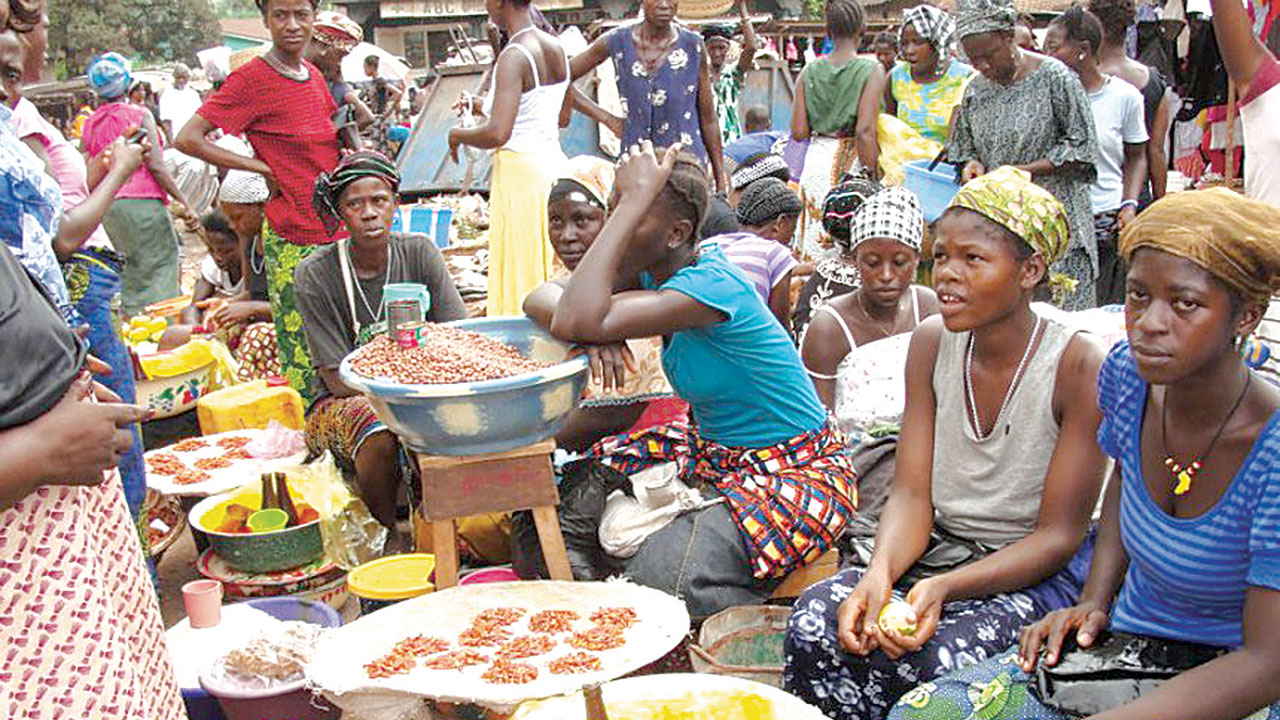Economy
Global Food Prices Jump 11th Consecutive Month in April

By Adedapo Adesanya
The prices of food commodity globally rose for the 11th consecutive month in April 2021, led by sugar, oil, and meat, the Food and Agriculture Organisation of the United Nations (FAO) has said.
The FAO said this in its Food Price Index report released on Thursday. The index tracks international prices of most commonly traded food commodities.
The FAO Food Price Index averaged 120.9 points in April, 1.7 per cent higher than March 2021 and 30.8 per cent higher than the same period of last year.
“The increase marked the 11th conservative monthly rise in the value of the FAO Food Price Index to its highest level since May 2014.
“And in nominal terms is 12 per cent below its all-time peak in February 2011,” it said.
The FAO Sugar Price Index increased 39 per cent from March and reached levels nearly 60 per cent above those registered in the corresponding month last year.
“The April rebound in international sugar price quotations was prompted by strong buying amid heightened concerns over tighter global supplies in 2020/21, due to the slow harvest progress in Brazil and frost damage in France.
“Further support was provided by the strengthening of the Brazilian Real against the US Dollar, which tends to affect shipments from Brazil, the world’s largest sugar exporter.
According to the report, the FAO Vegetable Oil Price Index averaged 162.0 points in April, up 1.8 per cent month-on-month, driven by rising soy, rapeseed and palm oil quotations more than offsetting lower sunflower oil values.
“International palm oil prices continued to rise in April on concerns over slower-than-expected production growth in major exporting countries.
“Soy and rapeseed oil values climbed further too, underpinned by respectively, firm global demand, including from biodiesel producers and protracted global supply tightness.
“By contrast, international prices of sunflower oil contracted moderately on-demand rationing,” it said.
In the report, the FAO Meat Price Index averaged 101.8 points in April, up 1.7 per cent from the slightly revised value for March, marking a seventh consecutive monthly increase and raising the index by 5.1 per cent above the corresponding month last year.
“In April, bovine and ovine meat quotations rose, underpinned by solid demand from East Asia, amidst tight supplies from Oceania due to ongoing herd rebuilding and low inventories.
“Elevated internal sales in some producing regions also supported bovine and ovine meat prices.
“Pig meat quotations firmed on continued high purchases by East Asia, despite increased overall shipments from the European Union, while Germany continued with no access to the Chinese market over African swine fever concerns.
“Meanwhile, poultry meat prices remained steady, reflecting generally balanced global markets,” the report said.
The report said the FAO Cereal Price Index averaged 125.1 points in April, up 1.2 per cent from March, resuming its climb after a short-lived one-month respite in March, and stood 26 per cent above its April 2020 level.
“Maize prices rose 5.7 per cent in April.
“With overall tightening maize supplies, on top of continued strong demand, maize prices stood 66.7 per cent above their values one year earlier and remain at their highest level since mid-2013.
“Among other coarse grains, international barley and sorghum prices continued to soften, falling 1.2 and 1.0 per cent in April but remained 26.8 and 86.5 per cent above their respective values in the corresponding month last year,” it said.
International wheat prices were generally steady in April, remaining over 17 per cent above their April 2020 values.
“By contrast, international rice prices decreased again in April, mainly reflecting currency movements and slow trading activities, with persistent logistical constraints and freight costs continuing to hinder fresh deals,” it said.
The report said the FAO Dairy Price Index averaged 118.9 points in April, up 1.2 per cent from March, rising for the eleventh consecutive month and lifting the index 24.1 per cent above its value a year ago.
“In April, butter quotations rose, underpinned by solid import demand from Asia, notwithstanding weaker internal demand in Europe.
“Skim milk powder prices increased due to high import demand from East Asia, induced partly by concerns over potential shipping delays amid limited spot supplies from Europe and Oceania.
“Cheese prices also increased due to high demand from Asia, amid lower-than-expected production in Europe and seasonally declining supplies from Oceania.
“By contrast, quotations for whole milk powder declined slightly, reflecting lower import demand for the available supplies, following significantly high volumes traded recently,” it said.
Economy
FAAC Disburses 1.727trn to FG, States Local Councils in December 2024

By Modupe Gbadeyanka
The federal government, the 36 states of the federation and the 774 local government areas have received N1.727 trillion from the Federal Accounts Allocation Committee (FAAC) for December 2024.
The funds were disbursed to the three tiers of government from the revenue generated by the nation in November 2024.
At the December meeting of FAAC held in Abuja, it was stated that the amount distributed comprised distributable statutory revenue of N455.354 billion, distributable Value Added Tax (VAT) revenue of N585.700 billion, Electronic Money Transfer Levy (EMTL) revenue of N15.046 billion and Exchange Difference revenue of N671.392 billion.
According to a statement signed on Friday by the Director of Press and Public Relations for FAAC, Mr Bawa Mokwa, the money generated last month was about N3.143 trillion, with N103.307 billion used for cost of collection and N1.312 trillion for transfers, interventions and refunds.
It was disclosed that gross statutory revenue of N1.827 trillion was received compared with the N1.336 trillion recorded a month earlier.
The statement said gross revenue of N628.972 billion was available from VAT versus N668.291 billion in the preceding month.
The organisation stated that last month, oil and gas royalty and CET levies recorded significant increases, while excise duty, VAT, import duty, Petroleum Profit Tax (PPT), Companies Income Tax (CIT) and EMTL decreased considerably.
As for the sharing, FAAC disclosed that from the N1.727 trillion, the central government got N581.856 billion, the states received N549.792 billion, the councils took N402.553 billion, while the benefiting states got N193.291 billion as 13 per cent derivation revenue.
From the N585.700 billion VAT earnings, the national government got N87.855 billion, the states received N292.850 billion and the local councils were given N204.995 billion.
Also, from the N455.354 billion distributable statutory revenue, the federal government was given N175.690 billion, the states got N89.113 billion, the local governments had N68.702 billion, and the benefiting states received N121.849 billion as 13 per cent derivation revenue.
In addition, from the N15.046 billion EMTL revenue, FAAC shared N2.257 billion to the federal government, disbursed N7.523 billion to the states and transferred N5.266 billion to the local councils.
Further, from the N671.392 billion Exchange Difference earnings, it gave central government N316.054 billion, the states N160.306 billion, the local government areas N123.590 billion, and the oil-producing states N71.442 billion as 13 per cent derivation revenue.
Economy
Okitipupa Plc, Two Others Lift Unlisted Securities Market by 0.65%

By Adedapo Adesanya
The NASD Over-the-Counter (OTC) Securities Exchange recorded a 0.65 per cent gain on Friday, December 13, boosted by three equities admitted on the trading platform.
On the last trading session of the week, Okitipupa Plc appreciated by N2.70 to settle at N29.74 per share versus Thursday’s closing price of N27.04 per share, FrieslandCampina Wamco Nigeria Plc added N2.49 to end the session at N42.85 per unit compared with the previous day’s N40.36 per unit, and Afriland Properties Plc gained 50 Kobo to close at N16.30 per share, in contrast to the preceding session’s N15.80 per share.
Consequently, the market capitalisation added N6.89 billion to settle at N1.062 trillion compared with the preceding day’s N1.055 trillion and the NASD Unlisted Security Index (NSI) gained 19.66 points to wrap the session at 3,032.16 points compared with 3,012.50 points recorded in the previous session.
Yesterday, the volume of securities traded by investors increased by 171.6 per cent to 1.2 million units from the 447,905 units recorded a day earlier, but the value of shares traded by the market participants declined by 19.3 per cent to N2.4 million from the N3.02 million achieved a day earlier, and the number of deals went down by 14.3 per cent to 18 deals from 21 deals.
At the close of business, Geo-Fluids Plc was the most active stock by volume on a year-to-date basis with a turnover of 1.7 billion units worth N3.9 billion, followed by Okitipupa Plc with the sale of 752.2 million units valued at N7.8 billion, and Afriland Properties Plc with 297.3 million units sold for N5.3 million.
In the same vein, Aradel Holdings Plc remained the most active stock by value on a year-to-date basis with the sale of 108.7 million units for N89.2 billion, trailed by Okitipupa Plc with 752.2 million units valued at N7.8 billion, and Afriland Properties Plc with a turnover of 297.3 million units worth N5.3 billion.
Economy
Naira Trades N1,533/$1 at Official Market, N1,650/$1 at Parallel Market

By Adedapo Adesanya
The Naira appreciated further against the United States Dollar at the Nigerian Autonomous Foreign Exchange Market (NAFEM) by N1.50 or 0.09 per cent to close at N1,533.00/$1 on Friday, December 13 versus the N1,534.50/$1 it was transacted on Thursday.
The local currency has continued to benefit from the Electronic Foreign Exchange Matching System (EFEMS) introduced by the Central Bank of Nigeria (CBN) this month.
The implementation of the forex system comes with diverse implications for all segments of the financial markets that deal with FX, including the rebound in the value of the Naira across markets.
The system instantly reflects data on all FX transactions conducted in the interbank market and approved by the CBN.
Market analysts say the publication of real-time prices and buy-sell orders data from this system has lent support to the Naira in the official market and tackled speculation.
In the official market yesterday, the domestic currency improved its value against the Pound Sterling by N12.58 to wrap the session at N1,942.19/£1 compared with the previous day’s N1,954.77/£1 and against the Euro, it gained N2.44 to close at N1,612.85/€1 versus Thursday’s closing price of N1,610.41/€1.
At the black market, the Nigerian Naira appreciated against the greenback on Friday by N30 to sell for N1,650/$1 compared with the preceding session’s value of N1,680/$1.
Meanwhile, the cryptocurrency market was largely positive as investors banked on recent signals, including fresh support from US President-elect, Mr Donald Trump, as well as interest rate cuts by the European Central Bank (ECB).
Ripple (XRP) added 7.3 per cent to sell at $2.49, Binance Coin (BNB) rose by 3.5 per cent to $728.28, Cardano (ADA) expanded by 2.4 per cent to trade at $1.11, Litecoin (LTC) increased by 2.3 per cent to $122.56, Bitcoin (BTC) gained 1.9 per cent to settle at $101,766.17, Dogecoin (DOGE) jumped by 1.2 per cent to $0.4064, Solana (SOL) soared by 0.7 per cent to $226.15 and Ethereum (ETH) advanced by 0.6 per cent to $3,925.35, while the US Dollar Tether (USDT) and the US Dollar Coin (USDC) remained unchanged at $1.00 each.
-

 Feature/OPED5 years ago
Feature/OPED5 years agoDavos was Different this year
-
Travel/Tourism8 years ago
Lagos Seals Western Lodge Hotel In Ikorodu
-

 Showbiz2 years ago
Showbiz2 years agoEstranged Lover Releases Videos of Empress Njamah Bathing
-

 Banking6 years ago
Banking6 years agoSort Codes of GTBank Branches in Nigeria
-

 Economy2 years ago
Economy2 years agoSubsidy Removal: CNG at N130 Per Litre Cheaper Than Petrol—IPMAN
-

 Banking2 years ago
Banking2 years agoFirst Bank Announces Planned Downtime
-

 Sports2 years ago
Sports2 years agoHighest Paid Nigerian Footballer – How Much Do Nigerian Footballers Earn
-

 Technology4 years ago
Technology4 years agoHow To Link Your MTN, Airtel, Glo, 9mobile Lines to NIN




















